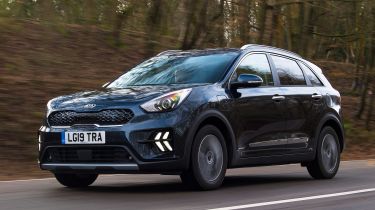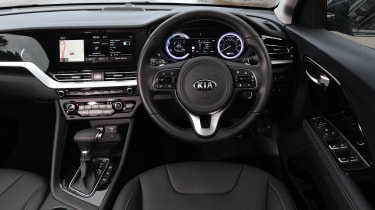New Kia Niro PHEV 2020 review
The revised Kia Niro PHEV may tempt many who can’t wait for the all-electric e-Niro

Given the length of the waiting list for the fabulous pure-electric Kia e-Niro, this plug-in-hybrid version is a worthy alternative that will suit many buyers looking for an easy driving experience matched with low running costs. This car is simple to live with, will be cheap to run if you can plug it in regularly, and is well equipped. It’s not cheap to buy, but there are good tax and fuel savings to be had, especially if your journeys are mostly short ones.
For many, a plug-in hybrid is the ideal stepping stone towards a fully electric future. You’ve got the ability to run on pure-electric power for short bursts or urban commuting, with an engine on board for longer journeys or a bit of extra power.
The fact is, most people who buy plug-in hybrids eventually take the plunge on a full EV at a later date. This works well for Kia, since it now (alongside sister company Hyundai) offers one model with three electrified options, hoping that, once you’re hooked, you’ll stay with the brand for all your EV needs. To recap, the Niro here is available as a Hybrid (no plug and very limited electric running), a plug-in hybrid (driven here with a 36-mile electric range), or as the hugely oversubscribed, fully electric e-Niro, which will do 282 miles on a single charge.
Used - available now
• Best plug-in hybrid cars on sale
Whichever model you choose, the Niro is a reasonably attractive and relatively spacious family crossover that’s well built and packed with kit. If you want this plug-in version, it doesn’t come cheap, however. Prices start at £30,265, although that is £4,230 less than the fully electric car.
The e-Niro benefits from the £3,500 government grant to bring its price down – a boon that was unhelpfully removed from plug-in hybrids over a year ago – although this car’s low 29g/km CO2 figure still offers big tax savings for company car drivers.
Order an e-Niro now and you’ll be faced with a long wait stretching well towards the end of 2020; the PHEV (Plug-in Hybrid Electric Vehicle) version is more readily available and is currently being offered with an attractive 5.9 per cent APR PCP finance deal – complete with a generous £2,000 deposit contribution from Kia.
So can the recently revised (with really no more than a mild facelift) Niro PHEV tempt those looking to take their first steps into electric car ownership? It does a good job.
The visual changes are subtle, with some new LED daytime running lights in the redesigned front bumper, slight tweaks to the rear, plus updated alloy wheel designs. Inside, there are some more soft-touch plastics, as well as the option of new colour packs. And Kia’s UVO CONNECT telematics system appears here for the first time.
As with the e-Niro, the Niro PHEV gets pretty close to its official electric range in everyday driving. Although the gauge in our car only showed 33 miles (compared with the official 36-mile figure) when it was fully charged, we completed a 27-mile test drive almost entirely on electric power, with seven miles’ worth of range left at the end.
At this point, the fuel economy read-out showed 144mpg (the official figure is a rather incredulous 201.8mpg), but there’s no doubt that if you regularly put your Niro PHEV on charge, it will reduce your running costs considerably. Topping up the 8.9kWh battery at home is likely to cost you less than a pound, but doing 35 miles on petrol power would probably set you back a fiver.
While company car drivers may like the sound of an e-Niro, the PHEV’s numbers aren’t to be sniffed at. From April 2020, the Niro plug-in will fall into the 12 per cent Benefit in Kind (BiK) tax band. A comparable (non-plug-in) Niro Hybrid sits a whole 10 percentage points higher, which could make a big difference to annual running costs.
The PHEV’s driving experience is pretty pleasing, too. You’d never describe it as fun, but on a gentle throttle, electric power will take care of most things. Yet even when the petrol engine stirs into life – if extra power is needed or when the battery charge is used up – things are still relatively quiet. And, of course, when you do use up all that electric power, the car still runs as a full hybrid, putting a little bit of energy back into the battery pack through braking.
So acceleration is gentle, but good enough, and the same applies to the ride comfort. The PHEV is only available in 2 or 3 trim levels (Kia uses numbers to keep it plain and simple); our car is a £31,945 3-spec car, which means comfy 16-inch wheels, with plenty of rubber surrounding them. The ride is still firm and a bit fidgety, but it’s never truly uncomfortable.
Visibility all round is good, it’s an easy car to get in and out of thanks to its slightly raised ride height, and there’s decent room for five passengers. The easy-to-access 324-litre boot (slightly smaller than in the full hybrid due to the bigger battery pack) is a good size and should suit families just fine.
The kit list was good on our car, too, with a lovely, bright 10.25-inch touchscreen that is responsive and easy to navigate. Wireless phone charging also features, as well as plush leather seats. All very generous for the price.















